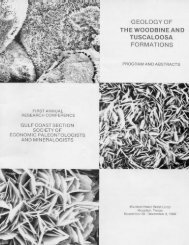Petroleum Systems of Deep-Water Basins - Gulf Coast Section SEPM
Petroleum Systems of Deep-Water Basins - Gulf Coast Section SEPM
Petroleum Systems of Deep-Water Basins - Gulf Coast Section SEPM
You also want an ePaper? Increase the reach of your titles
YUMPU automatically turns print PDFs into web optimized ePapers that Google loves.
Phase Changes: A Major Aspect <strong>of</strong> <strong>Deep</strong> <strong>Water</strong><br />
Hydrocarbon Migration<br />
Glen Gatenby<br />
Maxus (U.S.) Exploration Company<br />
1330 Lake Robbins Drive, Suite 300<br />
The Woodlands, Texas 77380<br />
e-mail: ggatenbym@repsol-ypf.com<br />
Abstract<br />
Hydrocarbon phase separation is a pervasive aspect <strong>of</strong> deep-water petroleum migration. Major oil fields in the<br />
deep water <strong>Gulf</strong> <strong>of</strong> Mexico are found at subsurface depths coinciding with significant changes in the solubility <strong>of</strong> oil<br />
in gas—suggesting that oil and gas phase separation is a pervasive step in petroleum migration. Additionally, changes<br />
in the solubility <strong>of</strong> methane in water coincide with the depth <strong>of</strong> gas reservoirs—suggesting that gas exsolving from<br />
water is also a process to consider in hydrocarbon migration.<br />
The solubility <strong>of</strong> oil in gas is calculated from Price’s experimental data and plotted versus depth. Increasing temperature<br />
and pressure with depth increases the solubility <strong>of</strong> oil in gas and it eventually becomes asymptotic, leading to<br />
the two becoming cosoluble. Vertically migrating hydrocarbons are most likely to phase separate at this depth. The<br />
importance <strong>of</strong> this depth <strong>of</strong> phase separation cannot be overstated as the largest fields are found proximally above this<br />
depth. Generally, as the magnitude <strong>of</strong> the change in solubility increases, the accumulation size also increases. Conversely,<br />
no commercial pays are found beneath the depth where oil and gas are cosoluble (an economic basement).<br />
The solubility <strong>of</strong> methane in water is calculated using Haas’ program and when plotted versus depth also reveals<br />
that major gas reservoirs are commonly found at the same depth where vertically migrating water would experience<br />
an abrupt decrease in methane solubility. Results from onshore <strong>Gulf</strong> <strong>of</strong> Mexico wells confirm methane saturation at<br />
high temperature and pressure and these waters would exsolve gas if the water migrated vertically.<br />
The solubility versus pay relationship is an improvement over the existing pressure versus pay relationship, and,<br />
this important new step in the hydrocarbon migration process, fortunately, can be modeled ahead <strong>of</strong> the bit, thus leading<br />
to the development <strong>of</strong> a new exploration strategy.<br />
29

















